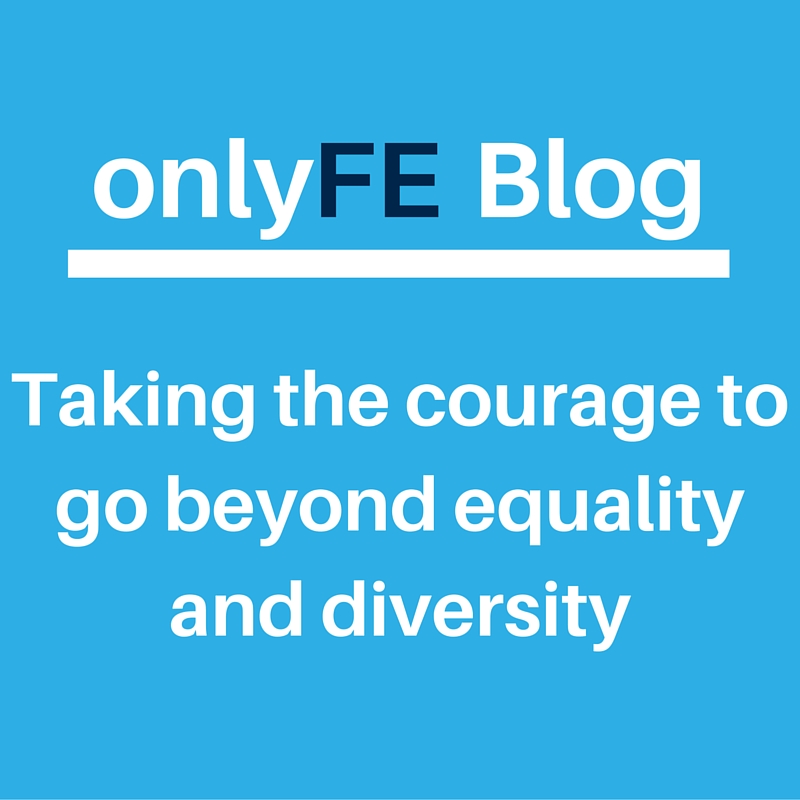9 DEC 2015
A world of difference – taking the courage to go beyond equality and diversity
It’s Sunday night, and across the country teachers will be busily working on lesson plans, marking books and turning the house upside down looking for post-it notes (actually that last one could just be me).

Guest post by Kay Sidebottom, Teacher Educator
at Barnsley College and Northern College.
It’s Sunday night, and across the country teachers will be busily working on lesson plans, marking books and turning the house upside down looking for post-it notes (actually that last one could just be me). They might also be considering how to embed equality and diversity in their sessions, particularly if they are going to be observed. Where this is done well it can be exciting, challenging and transformational; helping students to critically evaluate their own views and beliefs, learn about other identities and build communities within classrooms. However, all too often it is reduced to a tick-box exercise, with random activities shoe-horned in to please Ofsted or satisfy a managerial check-list.
In a world where we are already under pressure of time to deliver a growing syllabus in ever-reducing timetables, how can we make equality and diversity meaningful and truly embrace difference?
Part of the problem can stem from the very word ‘embed’. As a Teacher Educator, I’ve noticed my students seem flummoxed by it – does it mean to overtly teach this stuff? Or should we hide it somehow, and see if the students notice? My preference instead is ‘promote’, which links clearly to our requirements for action under the Equality Act 2010.
A more helpful question in our planning is therefore, ‘How can I best promote equality and diversity in my lessons?’
For me, promoting equality and diversity is firstly about connecting with the identities of the individuals within our classrooms; the ‘present identities’, some of which may be visible but may often be hidden, or even unknown. All too often we make assumptions about individuals based on the judgements of others or our past experiences.
Activities that help us to truly get to know individuals are the only way to start on the path to inclusive practice.
Taking an affirmative stance on diversity is also vital. The deficit approach used for students with specific learning needs can be limiting and damaging, as can labelling; only students themselves can explain what ADHD really means for them individually. What works for one student with dyslexia may well be detrimental for the learning of another. And our students may not want to use a label at all.
Turning neuro-diversity into a positive aspect which can be acknowledged and celebrated (and most of all, owned by the student) is empowering and liberating for everyone concerned.
Once we have connected with present identities we need to consider ‘who isn’t in the room’. Are we teaching a group of all white students in a health and social care, and what might this mean for their views on the world? Are we only teaching young men about motor mechanics, and what might this mean for the future of women in the motor vehicle industry?
Our task is therefore to bring ‘absent identities’ into the room, whether this is through the images and resources we use, the examples we give or the stories we tell and share.
The third and perhaps most challenging aspect of embedding diversity involves the examination of our own curriculum. For example, if what we are teaching is intrinsically based around the thinking of white, male, able-bodied theorists, our attempts to be inclusive will always be superficial.
We need to know the histories of our subjects and critically question how diverse the very roots of our syllabuses are.
A good place to start is by watching this brilliant NUS film, Why is my curriculum white? Ask similar questions about other under-represented identities too. Lastly, as teachers, we need to be gentle with ourselves. We can’t expect to be the font of all knowledge when it comes to diversity; but we do need to consider our own knowledge gaps and find ways to gain the information we need. New thinking about gender, race and culture, disability and neuro-diversity is emerging all the time. Reflecting on our practice, taking positive steps to address any gaps, and appreciating that we live in an uncertain and changing world will help us navigate our way through often challenging waters. Most importantly, having humility and a willingness to learn from any blunders will stand us in good stead.